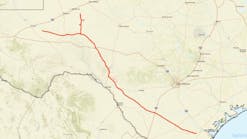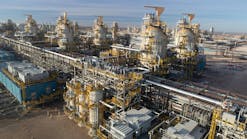With the rebound in oil and gas prices, US companies are continuing to increase spending for upstream operations for the coming year.
A number of US firms recently unveiled increases in upstream outlays for 2000, with many of the increases representing upward adjustments from plans announced at the start of the year.
Earlier, analysts at John S. Herold Inc. had reported that worldwide spending on upstream operations may increase 14% to nearly $86 billion as a result of better market conditions this year, after plunging more than 30% to just over $75 billion in 1999. Other industry analysts have forecast increases of 10-20% (OGJ, Apr. 10, 2000, p. 44).
In a separate yearend survey of about 90 US operators by Arthur Andersen officials, 64% of the respondents said they plan to increase US exploration outlays in 2000, while 67% indicated they would hike development spending.
Herold survey
Based on its survey of 217 oil and gas companies, Herold expects finding and development expenditures to increase about 10%, or $7 billion, to $71 billion worldwide in 2000, up from an estimated $64 billion in 1999. The balance of incremental spending will be targeted for acquisitions of proved properties, up nearly 37% to roughly $15 billion this year from an estimated $11 billion in 1999.
That would put acquisition spending slightly above the 1996 level of $14 billion but well below 1997-98 activity, which averaged nearly $21 billion/year.
According to Herold, large integrated oil companies will make the largest absolute increases in capital spending, up roughly $5 billion to $53 billion this year. But the biggest percentage jumps will be among pipelines, up nearly 40%; large US E&P firms, up 32%; and both small and midsized Canadian E&P companies, up 33% and 29%, respectively.
Herold sees a continuation of the upward trend in capital spending by pipeline companies, which has increased at a rate of 35%/year from $780 million in 1995.
Large US E&P companies are expected to increase their capital budgets to a total $13 billion this year, with some significant acquisitions such as Kerr-McGee Corp.'s purchase of Repsol-YPF SA's North Sea operations (OGJ, Dec. 20, 1999, p. 38). But their projected total spending for 2000 still falls 40% below the peak of $21 billion in 1997, Herold said.
It foresees lackluster performances by midsized US and non-US E&P firms, with spending increases of 7% and 9%, respectively. Midsized US E&P companies remain the most financially distressed group because of their inability to access capital.
Andersen survey
Victor A. Burk, managing director of Arthur Andersen's energy industry group, reported that 77% of the large independents and 66% of the other independents said they would boost exploration spending. But only 29% of the majors plan to increase US exploration.
"Similarly, only 14% of the majors plan higher spending for domestic development projects in 2000, compared with planned increases among 92% of the large independents and 68% of other independents," said Burk.
The majors and independents obviously have different outlooks.
"While independents rank the US and Canada as the most attractive areas for exploration and development," Burk said, "the majors rated West Africa and the Middle East ahead of the US. The majors are focusing their [US] exploration and development activities in a few select areas such as the deepwater Gulf of Mexico."
An overwhelming 87% of the respondents to the Arthur Andersen survey said there are still significant US gas reserves to be discovered. But 42% said an average gas price of $2.50/Mcf would be necessary to increase the reserve base. Another 44% said it would require even higher prices-up to $3.50/Mcf.
As for oil prices, 39% said $20/bbl would be necessary to add reserves, while 21% indicated higher prices, up to $25/bbl.
But some independents are still planning projects to be profitable at $2/Mcf or $15/bbl.
Mitchell
Mitchell Energy & Development Corp., The Woodlands, Tex., is hiking its 2001 fiscal budget a whopping 50% to $221.5 million, up from last year's expenditures of $147.8 million, excluding its acquisition of the Jameson gas processing plant.
The bulk of Mitchell's new budget, $183.1 million, will fund exploration and production, with $36.2 million earmarked for gas services and the remainder for corporate projects, officials said.
"We have stepped up our capital spending to take advantage of the favorable outlook for natural gas and our extensive drilling backlog in the Barnett shale formation in North Texas, where we will drill more than twice as many wells as last year," said George P. Mitchell, chairman and chief executive officer.
"We also see some attractive growth opportunities in our gathering and processing operations, especially in north and southeast Texas," he said. As part of Mitchell Energy's accelerated drilling program, it has budgeted $127 million to drill 196 net wells, up from the $85 million spent on 111 net wells during last fiscal year. The focus remains on developing the Barnett shale, where 136 wells are planned. Officials said the light sand fracture technology that was successfully applied in the Barnett will also be extended to wells in Limestone and Freestone counties in East Texas, with 26 wells scheduled for that area.
Mitchell Energy also has earmarked about $16 million to continue the aggressive workover program it started last spring. A total of 100 wells are scheduled for recompletion-60 in the Barnett and another 40 in other fields. The recompletion and accelerated drilling programs are expected to increase its annual natural gas production by about 15% over last year's level.
USX-Marathon
The USX-Marathon Group plans 2000 capital, investment, and exploration budget of $1.7 billion, up from $1.6 billion last year. That includes $713 million for production activities and $692 million for refining.
Marathon's upstream capital spending is expected to total $595 million this year, up from $430 million in 1999. The company will spend $248 million on worldwide exploration, with 75% going to new ventures and prospects in North America. That total is down from $257 million last year.
Programs include completion of the Petronius project on Viosca Knoll Block 786 in the Gulf of Mexico, which is expected to begin production in the third quarter. Company officials also plan to acquire other producing properties and will continue development of gas operations in East Texas and other basins in the western US and Canada.
Anadarko
Anadarko Petroleum Corp., Houston, bumped up its budget 13% to $766 million, from $680 million spent in 1999. About 16% of the new budget, $121 million, is earmarked for exploration, primarily on Alaska's North Slope, in the Gulf of Mexico, on the North Atlantic margin, and in Tunisia. That's down from $189 million last year.
The biggest portion, $527 million, will fund continued development of key projects in Algeria and the Gulf of Mexico, as well as in Alaska and other US onshore fields-particularly Anadarko's prolific Bossier play in East Texas. Last year, the Houston-based independent spent $311 million on development.
Another $22 million is budgeted for acquisitions, gas gathering, and other operations, down from $77 million spent in 1999. About 80% of Anadarko's total 2000 budget is earmarked for US operations.
Devon
Devon Energy Corp. hiked its budget to $510 million, up significantly from what it and PennzEnergy both were spending prior to their merger in 1999. About 70% of the new funds will be allocated to the US, with 23% going to Canada and 7% to other non-US projects.
The new budget includes $115 million to exploit proved reserves. Another $395 million is earmarked for other operations, including $255 million for low-risk projects and $125 million for new high-risk, high-reward prospects. And $15 million is designated for construction of gas gathering and processing systems in the Powder River basin of Wyoming, where Devon is a major participant in that coalbed methane play.
The company expects to keep 12 or more rigs working in that basin this year, drilling 500-600 wells. The firm also may drill another 80 coalbed methane wells in the Raton basin in Colorado.
Vastar
After pushing its 1999 total reserves to a record high, Vastar Resources Inc. boosted its 2000 capital budget by 28% to $850 million, up from $664 million last year. Of that, 54%, or $460 million, will finance development of Vastar's producing fields through additional drilling, recompletions, and installing or upgrading production facilities. That's up from $355 million that the Houston-based producer spent on development in 1999.
This year, Vastar will focus development efforts principally on 23 offshore properties in the Gulf of Mexico that it acquired from the former Mobil Corp. in 1998. The firm has identified hundreds of development opportunities on those properties.
Another 32%, or $270 million, of the new budget will be spent on exploration efforts, primarily in the gulf. Vastar plans to participate in drilling as many as 6 deepwater wells, along with about 40 exploratory or field extension wells on the shelf, officials said.
Last year, the company spent $248 million on exploration, racking up a 68% success rate with 40 successful wells of the 59 drilled.
The remaining 14% of Vastar's 2000 budget, $120 million, will be used for acquisitions and other opportunities that may arise during the year.

